Attached files
| file | filename |
|---|---|
| 8-K - 8-K - TRINITY INDUSTRIES INC | a081214q2investorpresentat.htm |
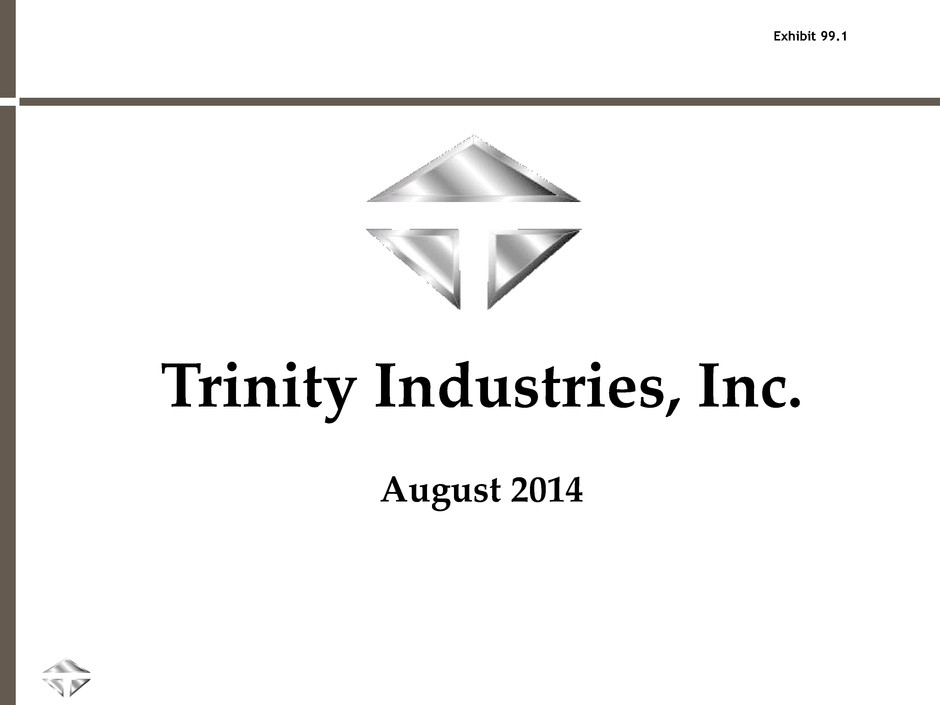
Trinity Industries, Inc. August 2014 Exhibit 99.1
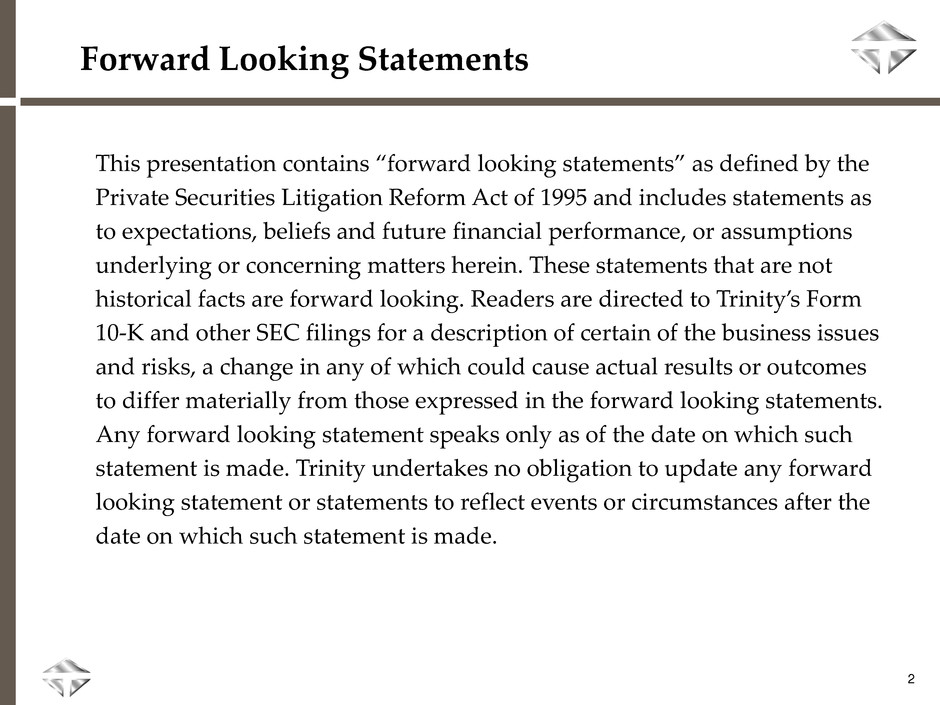
2 Forward Looking Statements This presentation contains “forward looking statements” as defined by the Private Securities Litigation Reform Act of 1995 and includes statements as to expectations, beliefs and future financial performance, or assumptions underlying or concerning matters herein. These statements that are not historical facts are forward looking. Readers are directed to Trinity’s Form 10-K and other SEC filings for a description of certain of the business issues and risks, a change in any of which could cause actual results or outcomes to differ materially from those expressed in the forward looking statements. Any forward looking statement speaks only as of the date on which such statement is made. Trinity undertakes no obligation to update any forward looking statement or statements to reflect events or circumstances after the date on which such statement is made.
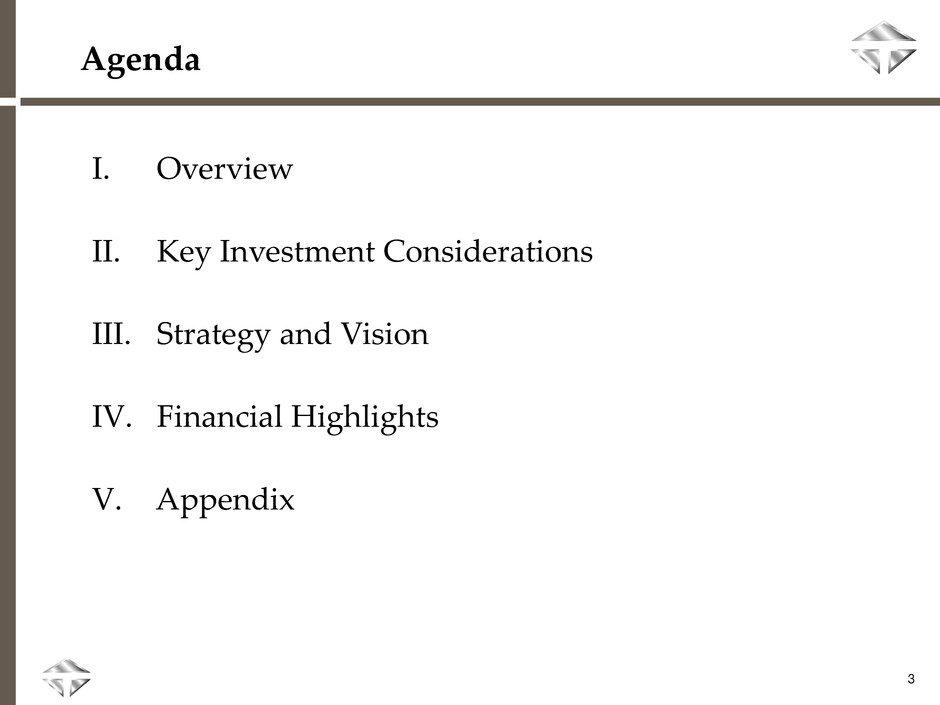
3 Agenda I. Overview II. Key Investment Considerations III. Strategy and Vision IV. Financial Highlights V. Appendix
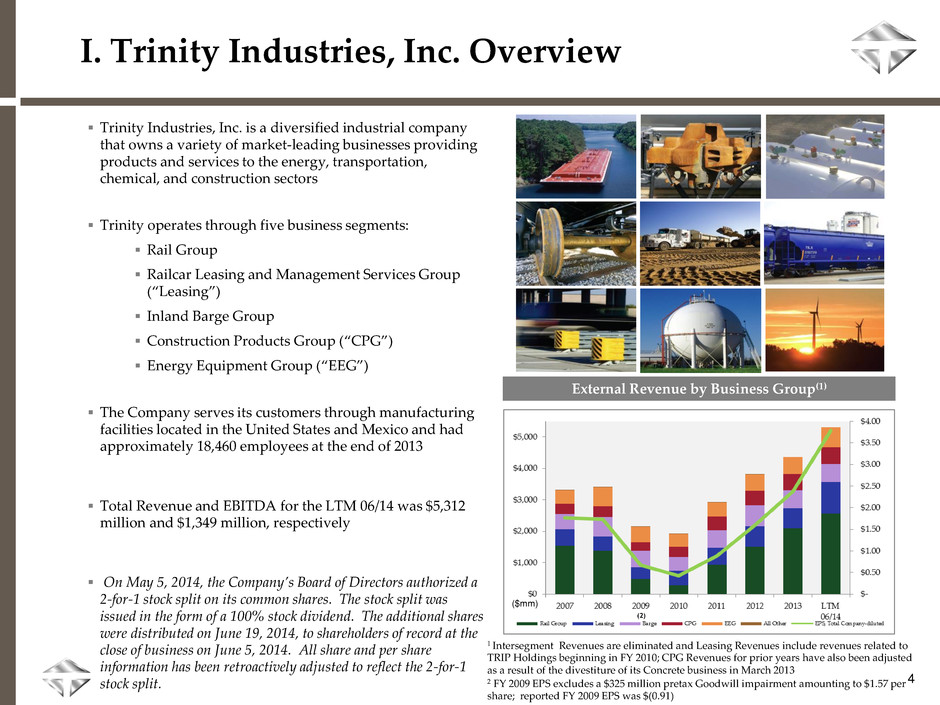
I. Trinity Industries, Inc. Overview 4 Trinity Industries, Inc. is a diversified industrial company that owns a variety of market-leading businesses providing products and services to the energy, transportation, chemical, and construction sectors Trinity operates through five business segments: Rail Group Railcar Leasing and Management Services Group (“Leasing”) Inland Barge Group Construction Products Group (“CPG”) Energy Equipment Group (“EEG”) The Company serves its customers through manufacturing facilities located in the United States and Mexico and had approximately 18,460 employees at the end of 2013 Total Revenue and EBITDA for the LTM 06/14 was $5,312 million and $1,349 million, respectively On May 5, 2014, the Company’s Board of Directors authorized a 2-for-1 stock split on its common shares. The stock split was issued in the form of a 100% stock dividend. The additional shares were distributed on June 19, 2014, to shareholders of record at the close of business on June 5, 2014. All share and per share information has been retroactively adjusted to reflect the 2-for-1 stock split. External Revenue by Business Group(1) 1 Intersegment Revenues are eliminated and Leasing Revenues include revenues related to TRIP Holdings beginning in FY 2010; CPG Revenues for prior years have also been adjusted as a result of the divestiture of its Concrete business in March 2013 2 FY 2009 EPS excludes a $325 million pretax Goodwill impairment amounting to $1.57 per share; reported FY 2009 EPS was $(0.91) ($mm) (2)
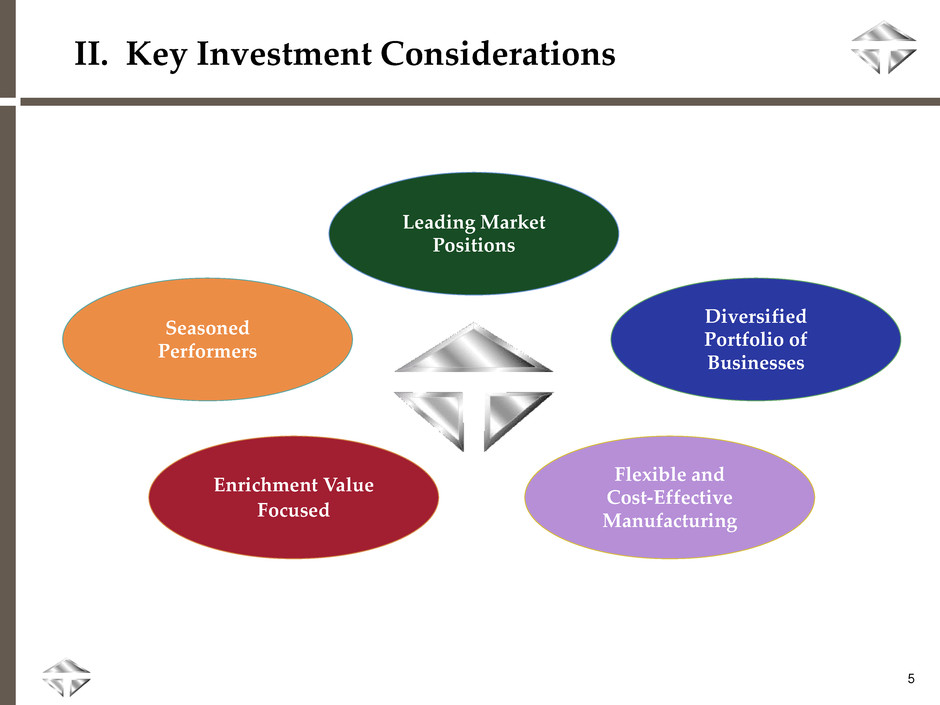
II. Key Investment Considerations 5 Leading Market Positions Diversified Portfolio of Businesses Flexible and Cost-Effective Manufacturing Seasoned Performers Enrichment Value Focused
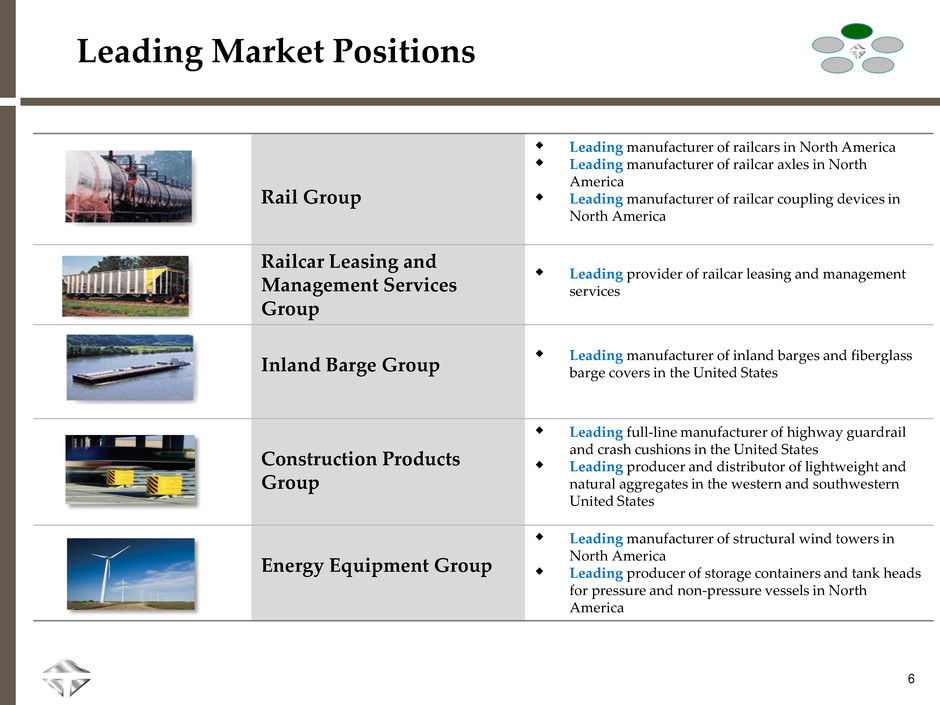
Leading Market Positions 6 Rail Group Leading manufacturer of railcars in North America Leading manufacturer of railcar axles in North America Leading manufacturer of railcar coupling devices in North America Railcar Leasing and Management Services Group Leading provider of railcar leasing and management services Inland Barge Group Leading manufacturer of inland barges and fiberglass barge covers in the United States Construction Products Group Leading full-line manufacturer of highway guardrail and crash cushions in the United States Leading producer and distributor of lightweight and natural aggregates in the western and southwestern United States Energy Equipment Group Leading manufacturer of structural wind towers in North America Leading producer of storage containers and tank heads for pressure and non-pressure vessels in North America
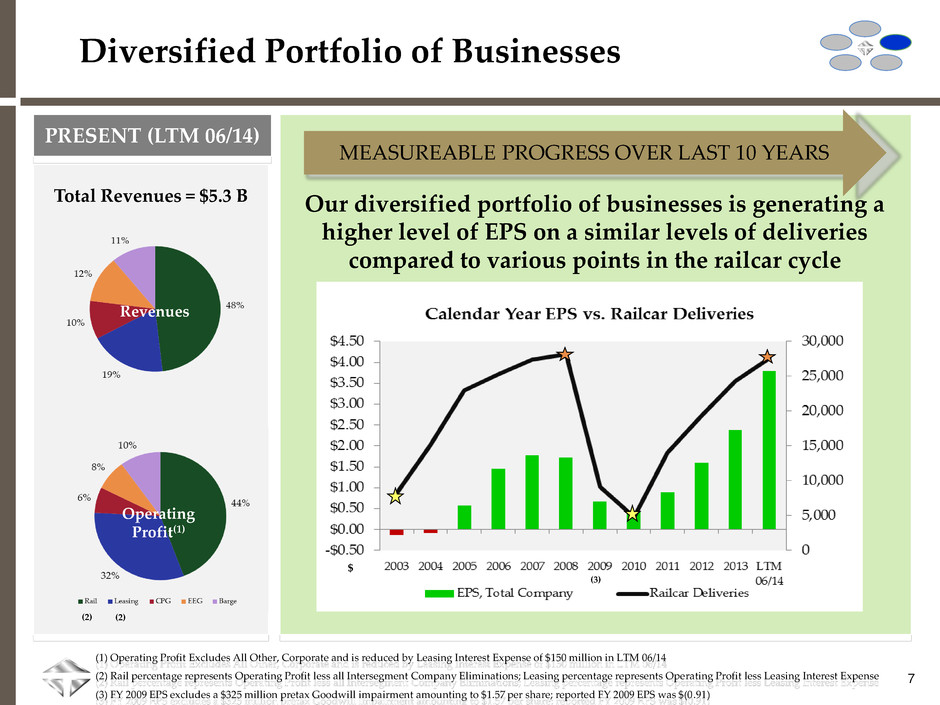
Diversified Portfolio of Businesses 7 PRESENT (LTM 06/14) MEASUREABLE PROGRESS OVER LAST 10 YEARS Total Revenues = $5.3 B Our diversified portfolio of businesses is generating a higher level of EPS on a similar levels of deliveries compared to various points in the railcar cycle (1) Operating Profit Excludes All Other, Corporate and is reduced by Leasing Interest Expense of $150 million in LTM 06/14 (2) Rail percentage represents Operating Profit less all Intersegment Company Eliminations; Leasing percentage represents Operating Profit less Leasing Interest Expense (3) FY 2009 EPS excludes a $325 million pretax Goodwill impairment amounting to $1.57 per share; reported FY 2009 EPS was $(0.91) (2) (2) Units Revenues Operating Profit(1) $ (3)
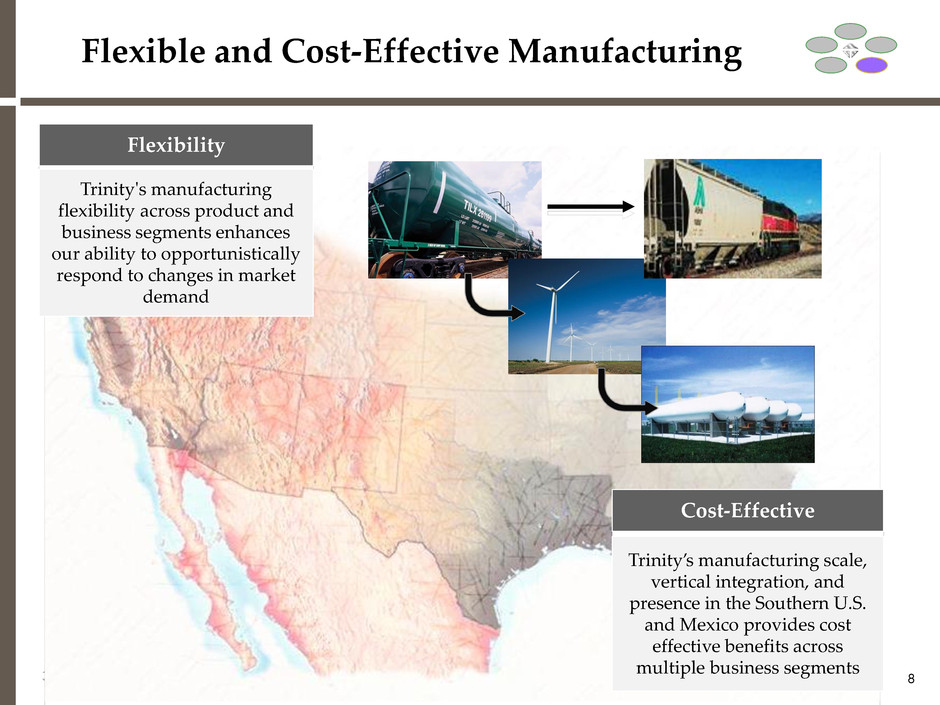
Flexible and Cost-Effective Manufacturing 8 Flexibility Cost-Effective Trinity's manufacturing flexibility across product and business segments enhances our ability to opportunistically respond to changes in market demand Trinity’s manufacturing scale, vertical integration, and presence in the Southern U.S. and Mexico provides cost effective benefits across multiple business segments
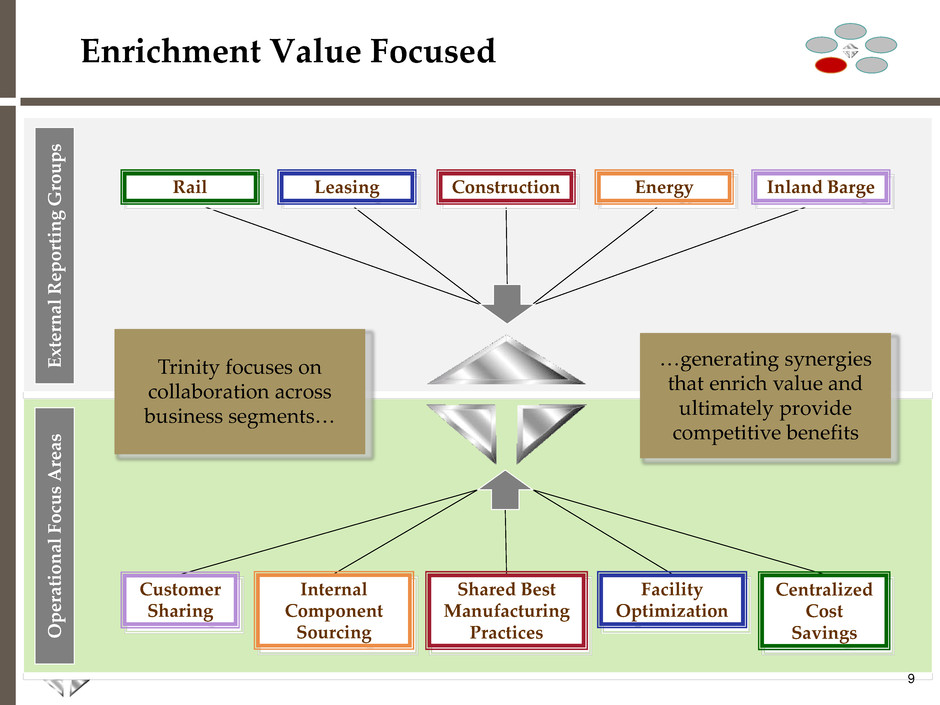
Enrichment Value Focused 9 E x te rn a l R e p o rti n g G ro u p s O p e ra tio n a l Foc u s A re a s Rail Leasing Construction Energy Inland Barge Customer Sharing Internal Component Sourcing Shared Best Manufacturing Practices Facility Optimization Centralized Cost Savings Trinity focuses on collaboration across business segments… …generating synergies that enrich value and ultimately provide competitive benefits
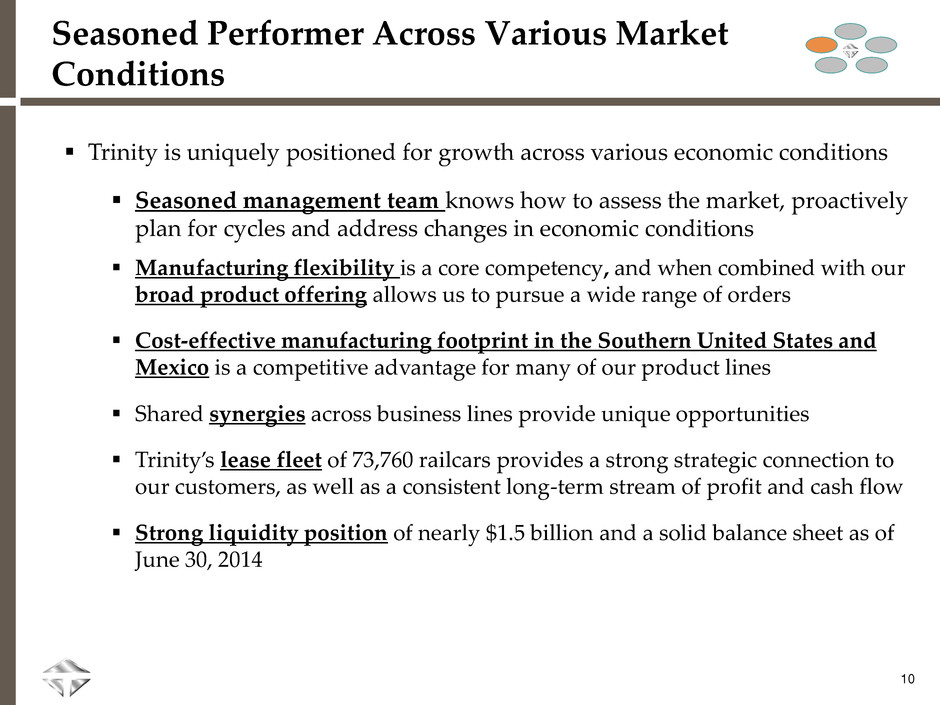
10 Seasoned Performer Across Various Market Conditions Trinity is uniquely positioned for growth across various economic conditions Seasoned management team knows how to assess the market, proactively plan for cycles and address changes in economic conditions Manufacturing flexibility is a core competency, and when combined with our broad product offering allows us to pursue a wide range of orders Cost-effective manufacturing footprint in the Southern United States and Mexico is a competitive advantage for many of our product lines Shared synergies across business lines provide unique opportunities Trinity’s lease fleet of 73,760 railcars provides a strong strategic connection to our customers, as well as a consistent long-term stream of profit and cash flow Strong liquidity position of nearly $1.5 billion and a solid balance sheet as of June 30, 2014
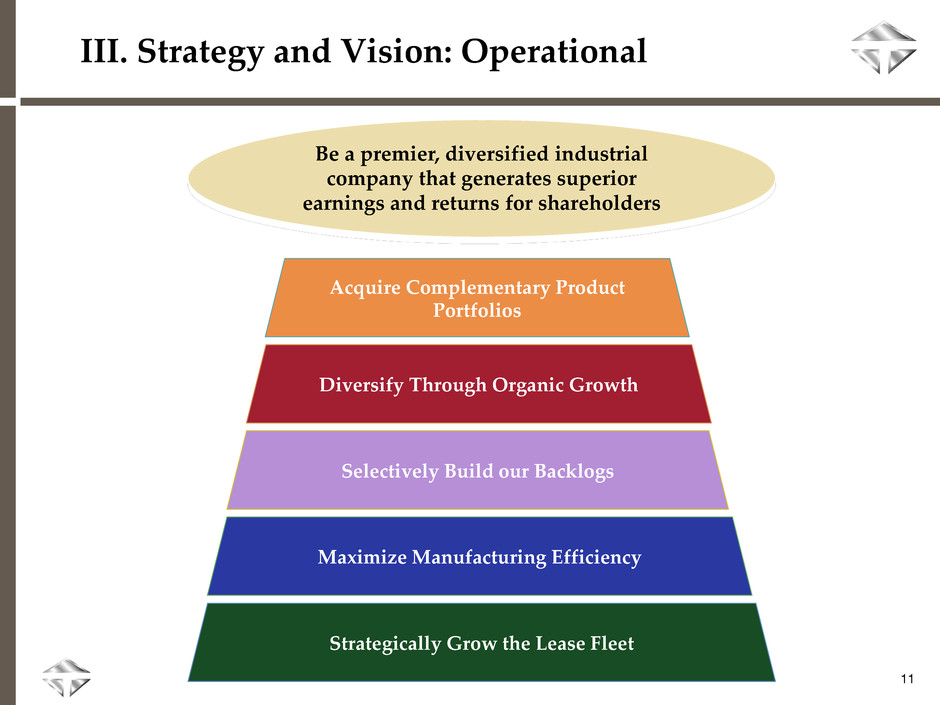
III. Strategy and Vision: Operational 11 Strategically Grow the Lease Fleet Maximize Manufacturing Efficiency Selectively Build our Backlogs Diversify Through Organic Growth Acquire Complementary Product Portfolios Be a premier, diversified industrial company that generates superior earnings and returns for shareholders
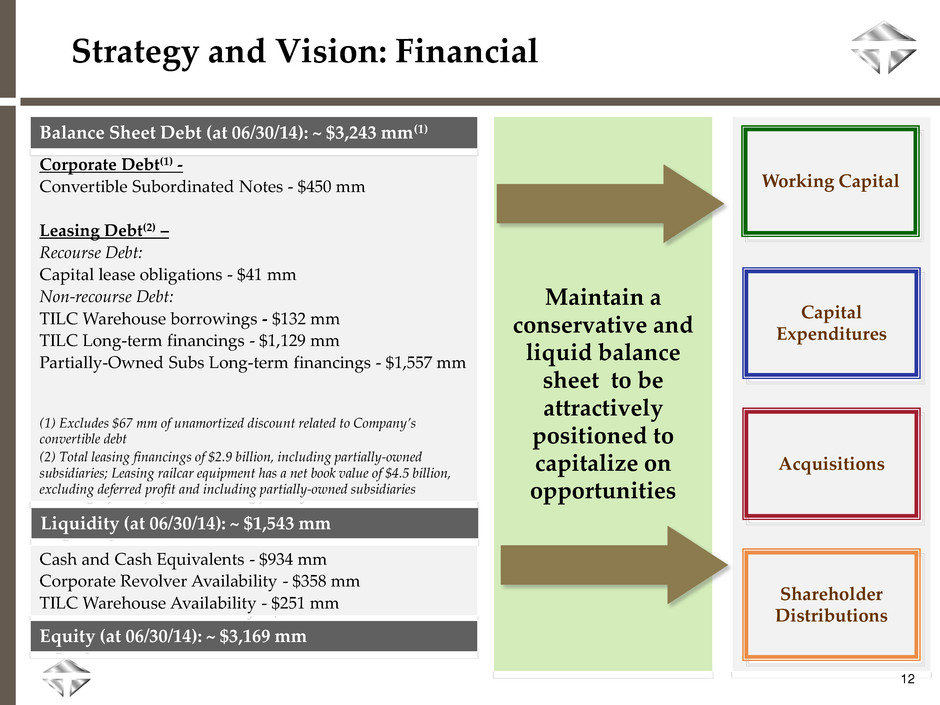
Liquidity (at 06/30/14): ~ $1,543 mm Strategy and Vision: Financial 12 Maintain a conservative and liquid balance sheet to be attractively positioned to capitalize on opportunities Working Capital Capital Expenditures Acquisitions Shareholder Distributions Corporate Debt(1) - Convertible Subordinated Notes - $450 mm Leasing Debt(2) – Recourse Debt: Capital lease obligations - $41 mm Non-recourse Debt: TILC Warehouse borrowings - $132 mm TILC Long-term financings - $1,129 mm Partially-Owned Subs Long-term financings - $1,557 mm (1) Excludes $67 mm of unamortized discount related to Company’s convertible debt (2) Total leasing financings of $2.9 billion, including partially-owned subsidiaries; Leasing railcar equipment has a net book value of $4.5 billion, excluding deferred profit and including partially-owned subsidiaries Cash and Cash Equivalents - $934 mm Corporate Revolver Availability - $358 mm TILC Warehouse Availability - $251 mm Balance Sheet Debt (at 06/30/14): ~ $3,243 mm(1) Equity (at 06/30/14): ~ $3,169 mm
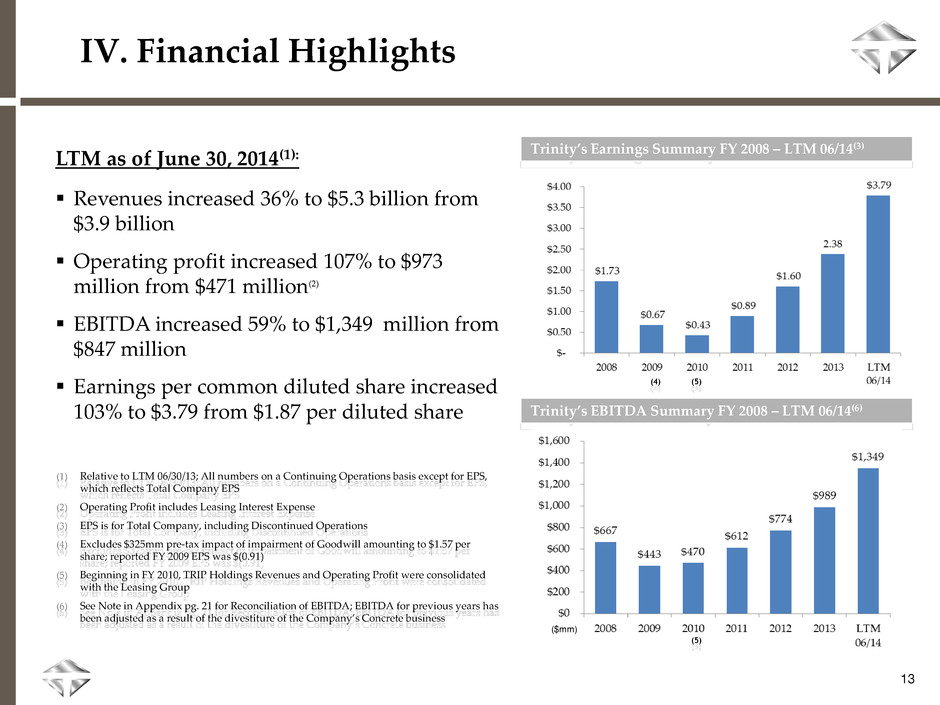
13 IV. Financial Highlights Trinity’s Earnings Summary FY 2008 – LTM 06/14(3) LTM as of June 30, 2014(1): Revenues increased 36% to $5.3 billion from $3.9 billion Operating profit increased 107% to $973 million from $471 million(2) EBITDA increased 59% to $1,349 million from $847 million Earnings per common diluted share increased 103% to $3.79 from $1.87 per diluted share Trinity’s EBITDA Summary FY 2008 – LTM 06/14(6) (1) Relative to LTM 06/30/13; All numbers on a Continuing Operations basis except for EPS, which reflects Total Company EPS (2) Operating Profit includes Leasing Interest Expense (3) EPS is for Total Company, including Discontinued Operations (4) Excludes $325mm pre-tax impact of impairment of Goodwill amounting to $1.57 per share; reported FY 2009 EPS was $(0.91) (5) Beginning in FY 2010, TRIP Holdings Revenues and Operating Profit were consolidated with the Leasing Group (6) See Note in Appendix pg. 21 for Reconciliation of EBITDA; EBITDA for previous years has been adjusted as a result of the divestiture of the Company’s Concrete business Need to Update (4) (5) ($mm) (5)
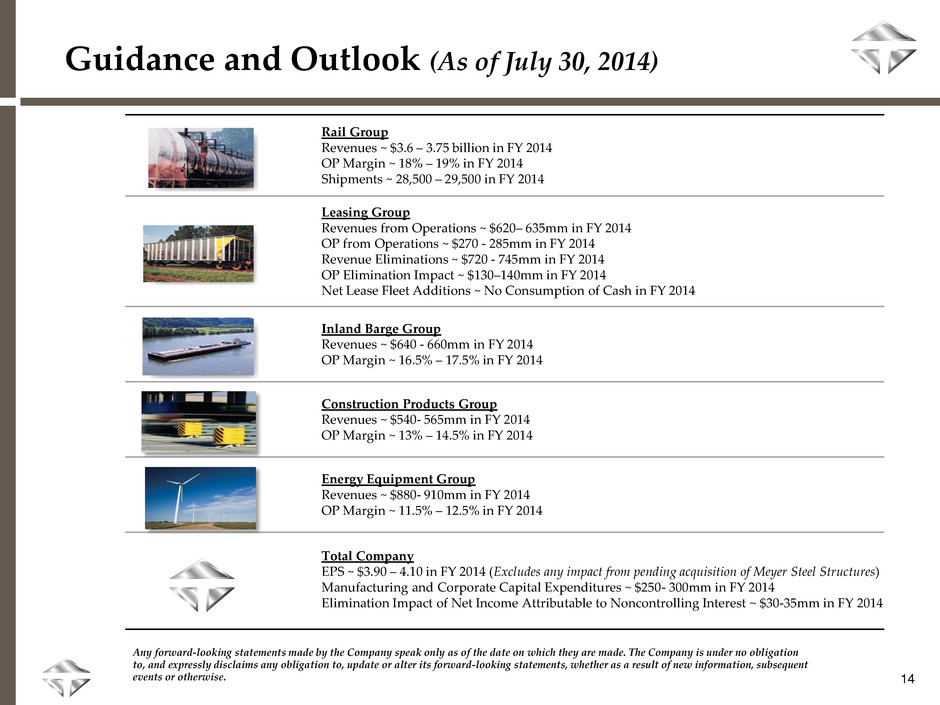
Guidance and Outlook (As of July 30, 2014) 14 Rail Group Revenues ~ $3.6 – 3.75 billion in FY 2014 OP Margin ~ 18% – 19% in FY 2014 Shipments ~ 28,500 – 29,500 in FY 2014 Leasing Group Revenues from Operations ~ $620– 635mm in FY 2014 OP from Operations ~ $270 - 285mm in FY 2014 Revenue Eliminations ~ $720 - 745mm in FY 2014 OP Elimination Impact ~ $130–140mm in FY 2014 Net Lease Fleet Additions ~ No Consumption of Cash in FY 2014 Inland Barge Group Revenues ~ $640 - 660mm in FY 2014 OP Margin ~ 16.5% – 17.5% in FY 2014 Construction Products Group Revenues ~ $540- 565mm in FY 2014 OP Margin ~ 13% – 14.5% in FY 2014 Energy Equipment Group Revenues ~ $880- 910mm in FY 2014 OP Margin ~ 11.5% – 12.5% in FY 2014 Total Company EPS ~ $3.90 – 4.10 in FY 2014 (Excludes any impact from pending acquisition of Meyer Steel Structures) Manufacturing and Corporate Capital Expenditures ~ $250- 300mm in FY 2014 Elimination Impact of Net Income Attributable to Noncontrolling Interest ~ $30-35mm in FY 2014 Any forward-looking statements made by the Company speak only as of the date on which they are made. The Company is under no obligation to, and expressly disclaims any obligation to, update or alter its forward-looking statements, whether as a result of new information, subsequent events or otherwise.
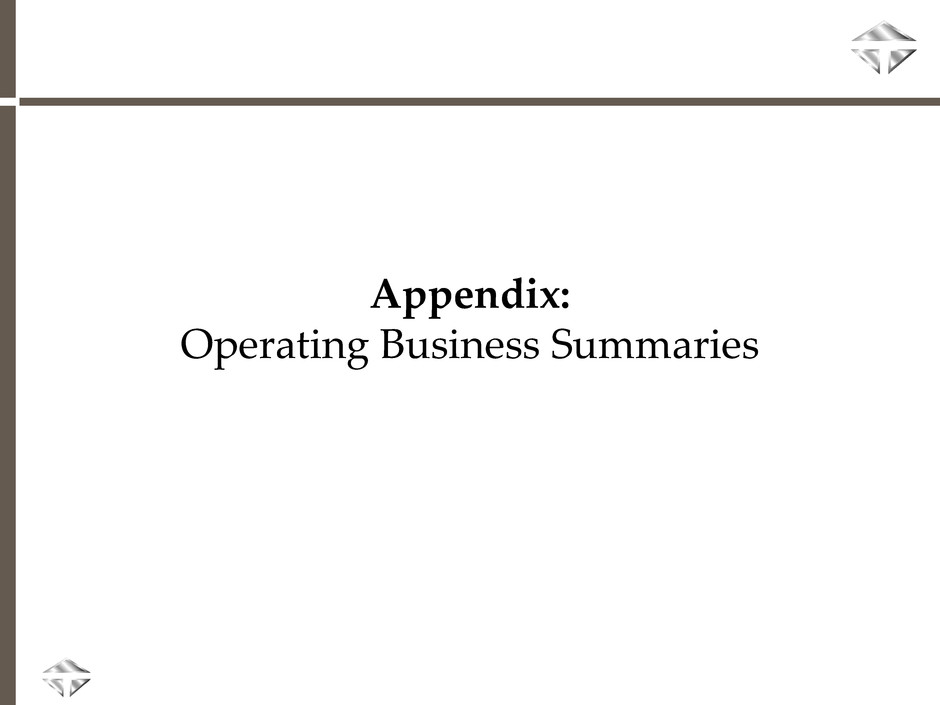
Appendix: Operating Business Summaries
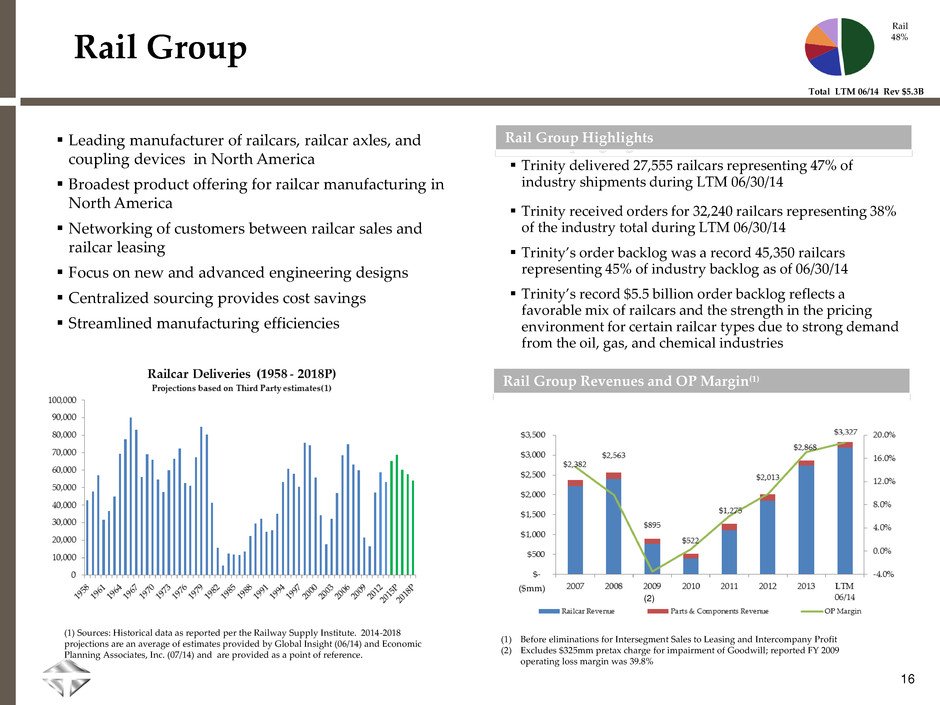
16 Trinity delivered 27,555 railcars representing 47% of industry shipments during LTM 06/30/14 Trinity received orders for 32,240 railcars representing 38% of the industry total during LTM 06/30/14 Trinity’s order backlog was a record 45,350 railcars representing 45% of industry backlog as of 06/30/14 Trinity’s record $5.5 billion order backlog reflects a favorable mix of railcars and the strength in the pricing environment for certain railcar types due to strong demand from the oil, gas, and chemical industries Rail Group Leading manufacturer of railcars, railcar axles, and coupling devices in North America Broadest product offering for railcar manufacturing in North America Networking of customers between railcar sales and railcar leasing Focus on new and advanced engineering designs Centralized sourcing provides cost savings Streamlined manufacturing efficiencies Rail Group Highlights Rail Group Revenues and OP Margin(1) (1) Before eliminations for Intersegment Sales to Leasing and Intercompany Profit (2) Excludes $325mm pretax charge for impairment of Goodwill; reported FY 2009 operating loss margin was 39.8% (1) Sources: Historical data as reported per the Railway Supply Institute. 2014-2018 projections are an average of estimates provided by Global Insight (06/14) and Economic Planning Associates, Inc. (07/14) and are provided as a point of reference. Rail 48% (2) ($mm) Total LTM 06/14 Rev $5.3B
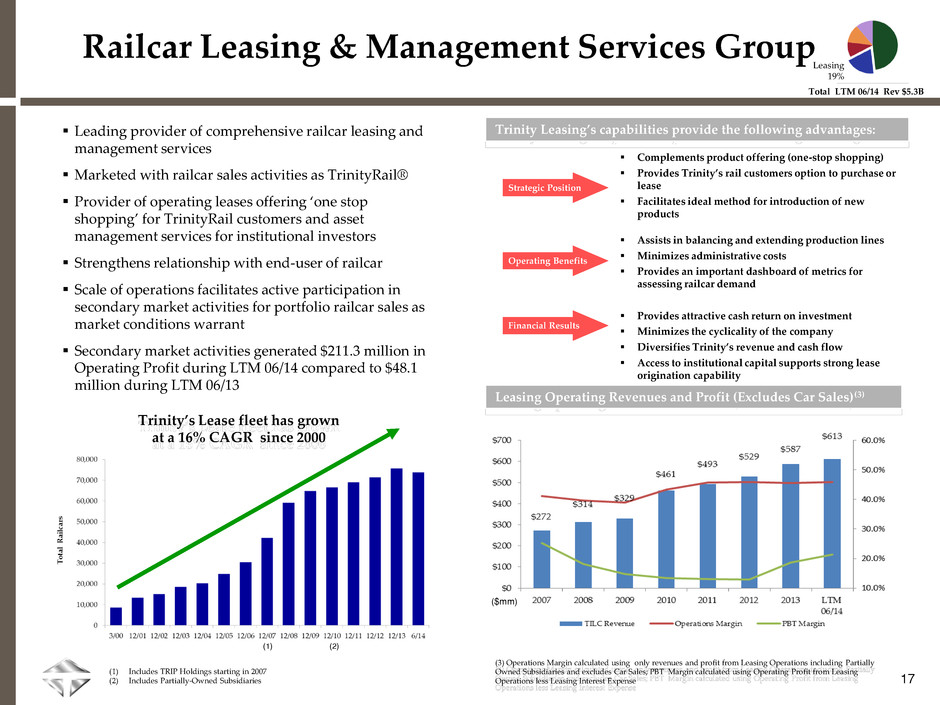
17 Railcar Leasing & Management Services Group Leading provider of comprehensive railcar leasing and management services Marketed with railcar sales activities as TrinityRail® Provider of operating leases offering ‘one stop shopping’ for TrinityRail customers and asset management services for institutional investors Strengthens relationship with end-user of railcar Scale of operations facilitates active participation in secondary market activities for portfolio railcar sales as market conditions warrant Secondary market activities generated $211.3 million in Operating Profit during LTM 06/14 compared to $48.1 million during LTM 06/13 Trinity Leasing’s capabilities provide the following advantages: Strategic Position Operating Benefits Financial Results Complements product offering (one-stop shopping) Provides Trinity’s rail customers option to purchase or lease Facilitates ideal method for introduction of new products Assists in balancing and extending production lines Minimizes administrative costs Provides an important dashboard of metrics for assessing railcar demand Provides attractive cash return on investment Minimizes the cyclicality of the company Diversifies Trinity’s revenue and cash flow Access to institutional capital supports strong lease origination capability Leasing Operating Revenues and Profit (Excludes Car Sales)(3) (3) Operations Margin calculated using only revenues and profit from Leasing Operations including Partially Owned Subsidiaries and excludes Car Sales; PBT Margin calculated using Operating Profit from Leasing Operations less Leasing Interest Expense (1) Includes TRIP Holdings starting in 2007 (2) Includes Partially-Owned Subsidiaries Trinity’s Lease fleet has grown at a 16% CAGR since 2000 Total LTM 06/14 Rev $5.3B (1) (2) ($mm) Leasing 19%
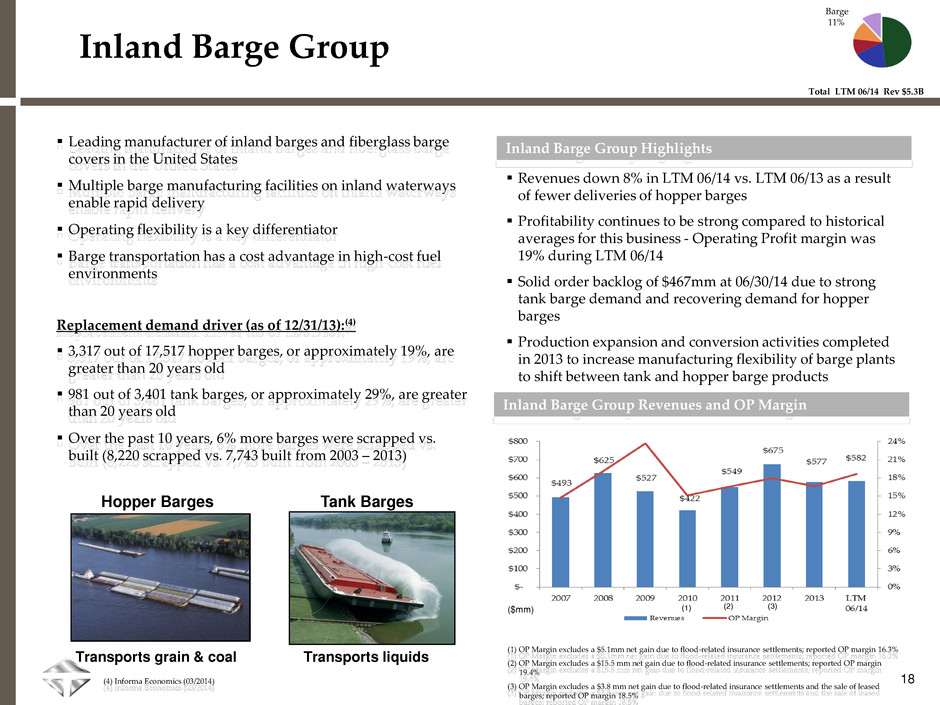
18 Revenues down 8% in LTM 06/14 vs. LTM 06/13 as a result of fewer deliveries of hopper barges Profitability continues to be strong compared to historical averages for this business - Operating Profit margin was 19% during LTM 06/14 Solid order backlog of $467mm at 06/30/14 due to strong tank barge demand and recovering demand for hopper barges Production expansion and conversion activities completed in 2013 to increase manufacturing flexibility of barge plants to shift between tank and hopper barge products Inland Barge Group Inland Barge Group Highlights Inland Barge Group Revenues and OP Margin Tank Barges Hopper Barges Transports grain & coal Transports liquids Leading manufacturer of inland barges and fiberglass barge covers in the United States Multiple barge manufacturing facilities on inland waterways enable rapid delivery Operating flexibility is a key differentiator Barge transportation has a cost advantage in high-cost fuel environments Replacement demand driver (as of 12/31/13):(4) 3,317 out of 17,517 hopper barges, or approximately 19%, are greater than 20 years old 981 out of 3,401 tank barges, or approximately 29%, are greater than 20 years old Over the past 10 years, 6% more barges were scrapped vs. built (8,220 scrapped vs. 7,743 built from 2003 – 2013) (1) OP Margin excludes a $5.1mm net gain due to flood-related insurance settlements; reported OP margin 16.3% (2) OP Margin excludes a $15.5 mm net gain due to flood-related insurance settlements; reported OP margin 19.4% (3) OP Margin excludes a $3.8 mm net gain due to flood-related insurance settlements and the sale of leased barges; reported OP margin 18.5% (4) Informa Economics (03/2014) Total LTM 06/14 Rev $5.3B ($mm) Barge 11% (1) (2) (3)
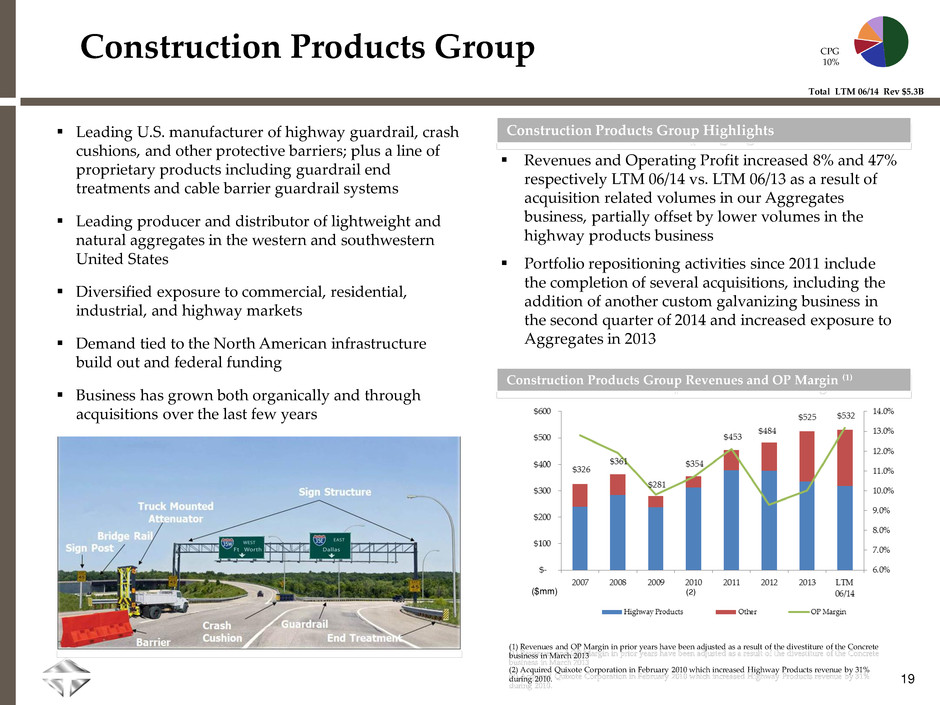
19 Revenues and Operating Profit increased 8% and 47% respectively LTM 06/14 vs. LTM 06/13 as a result of acquisition related volumes in our Aggregates business, partially offset by lower volumes in the highway products business Portfolio repositioning activities since 2011 include the completion of several acquisitions, including the addition of another custom galvanizing business in the second quarter of 2014 and increased exposure to Aggregates in 2013 Construction Products Group Leading U.S. manufacturer of highway guardrail, crash cushions, and other protective barriers; plus a line of proprietary products including guardrail end treatments and cable barrier guardrail systems Leading producer and distributor of lightweight and natural aggregates in the western and southwestern United States Diversified exposure to commercial, residential, industrial, and highway markets Demand tied to the North American infrastructure build out and federal funding Business has grown both organically and through acquisitions over the last few years Construction Products Group Highlights Construction Products Group Revenues and OP Margin (1) (1) Revenues and OP Margin in prior years have been adjusted as a result of the divestiture of the Concrete business in March 2013 (2) Acquired Quixote Corporation in February 2010 which increased Highway Products revenue by 31% during 2010. CPG 10% Total LTM 06/14 Rev $5.3B ($mm) (2)
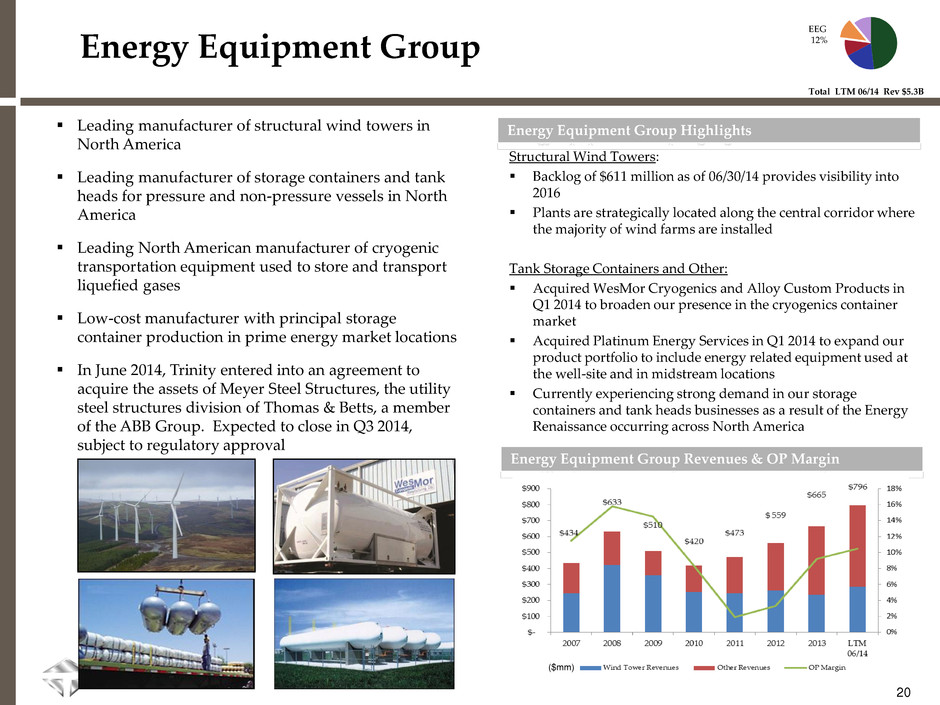
20 Structural Wind Towers: Backlog of $611 million as of 06/30/14 provides visibility into 2016 Plants are strategically located along the central corridor where the majority of wind farms are installed Tank Storage Containers and Other: Acquired WesMor Cryogenics and Alloy Custom Products in Q1 2014 to broaden our presence in the cryogenics container market Acquired Platinum Energy Services in Q1 2014 to expand our product portfolio to include energy related equipment used at the well-site and in midstream locations Currently experiencing strong demand in our storage containers and tank heads businesses as a result of the Energy Renaissance occurring across North America Energy Equipment Group Leading manufacturer of structural wind towers in North America Leading manufacturer of storage containers and tank heads for pressure and non-pressure vessels in North America Leading North American manufacturer of cryogenic transportation equipment used to store and transport liquefied gases Low-cost manufacturer with principal storage container production in prime energy market locations In June 2014, Trinity entered into an agreement to acquire the assets of Meyer Steel Structures, the utility steel structures division of Thomas & Betts, a member of the ABB Group. Expected to close in Q3 2014, subject to regulatory approval Energy Equipment Group Highlights Energy Equipment Group Revenues & OP Margin EEG 12% Total LTM 06/14 Rev $5.3B ($mm)
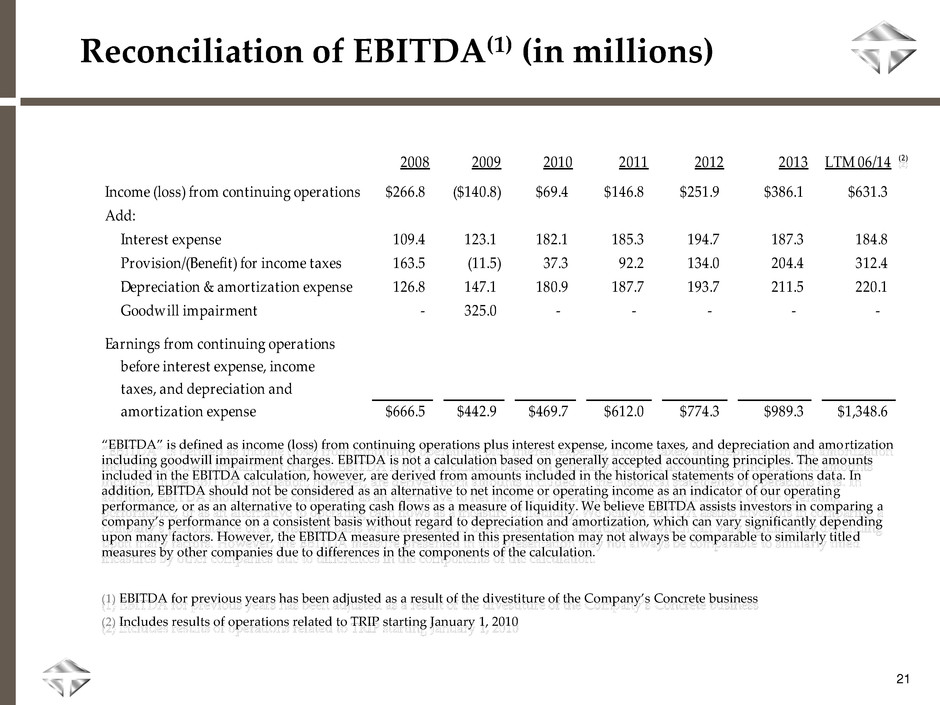
Reconciliation of EBITDA(1) (in millions) “EBITDA” is defined as income (loss) from continuing operations plus interest expense, income taxes, and depreciation and amortization including goodwill impairment charges. EBITDA is not a calculation based on generally accepted accounting principles. The amounts included in the EBITDA calculation, however, are derived from amounts included in the historical statements of operations data. In addition, EBITDA should not be considered as an alternative to net income or operating income as an indicator of our operating performance, or as an alternative to operating cash flows as a measure of liquidity. We believe EBITDA assists investors in comparing a company’s performance on a consistent basis without regard to depreciation and amortization, which can vary significantly depending upon many factors. However, the EBITDA measure presented in this presentation may not always be comparable to similarly titled measures by other companies due to differences in the components of the calculation. (1) EBITDA for previous years has been adjusted as a result of the divestiture of the Company’s Concrete business (2) Includes results of operations related to TRIP starting January 1, 2010 21 (2) 2008 2009 2010 2011 2012 2013 LTM 06/14 Income (loss) from continuing operations $266.8 ($140.8) $69.4 $146.8 $251.9 $386.1 $631.3 Add: Interest expense 109.4 123.1 182.1 185.3 194.7 187.3 184.8 Provisio /(Benefit) for income taxes 163.5 (11.5) 37.3 92.2 134.0 204.4 312.4 Depreciation & amortization expense 126.8 147.1 180.9 187.7 193.7 211.5 220.1 Goodwill impairment - 325.0 - - - - - Earnings from continuing operations before interest expense, income taxes, and depreciation and amortization expense $666.5 $442.9 $469.7 $612.0 $774.3 $989.3 $1,348.6
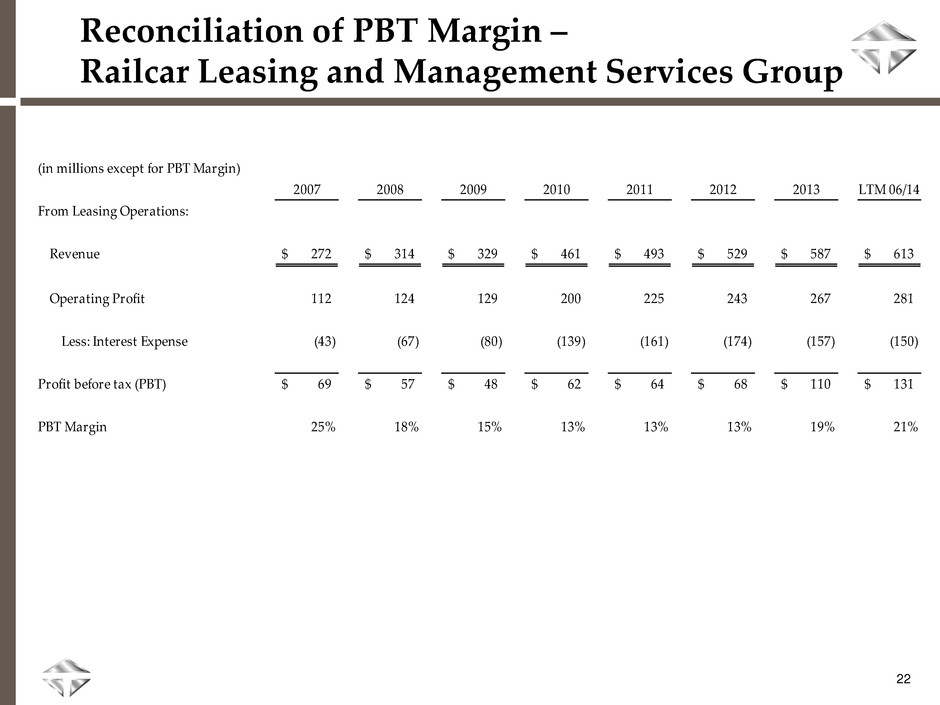
Reconciliation of PBT Margin – Railcar Leasing and Management Services Group 22 (in millions except for PBT Margin) 2007 2008 2009 2010 2011 2012 2013 LTM 06/14 From Leasing Operations: Revenue 272$ 314$ 329$ 461$ 493$ 529$ 587$ 613$ Operating Profit 112 124 129 200 225 243 267 281 Less: Interest Expense (43) (67) (80) (139) (161) (174) (157) (150) Profit before tax (PBT) 69$ 57$ 48$ 62$ 64$ 68$ 110$ 131$ PBT Margin 25% 18% 15% 13% 13% 13% 19% 21%
